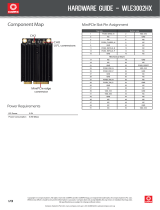
This module is intended for OEM integrators only. Per FCC KDB 996369 D03 OEM Manual v01
guidance, the following conditions must be strictly followed when using this certified module:
KDB 996369 D03 OEM Manual v01 rule sections:
2.2 List of applicable FCC rules
This module has been tested for compliance to FCC Part 15
2.3 Summarize the specific operational use conditions
The module is tested for standalone mobile RF exposure use condition. Any other usage
conditions such as co-location with other transmitter(s) or being used in a portable condition will
need a separate reassessment through a class II permissive change application or new
certification.
2.4 Limited module procedures
Not applicable.
2.5 Trace antenna designs
Not applicable.
2.6 RF exposure considerations
This equipment complies with FCC mobile radiation exposure limits set forth for an uncontrolled
environment. This equipment should be installed and operated with a minimum distance of 20cm
between the radiator & your body. If the module is installed in a portable host, a separate SAR
evaluation is required to confirm compliance with relevant FCC portable RF exposure rules.
2.7 Antennas
The following antennas have been certified for use with this module; antennas of the same type with equal or
lower gain may also be used with this module. The antenna must be installed such that 20 cm can be
maintained between the antenna and users.
2.8 Label and compliance information
The final end product must be labeled in a visible area with the following: “Contains FCC ID:
SERAOFN200”. The grantee's FCC ID can be used only when all FCC compliance requirements
are met.
2.9 Information on test modes and additional testing requirements
This transmitter is tested in a standalone mobile RF exposure condition and any co-located or
simultaneous transmission with other transmitter(s) or portable use will require a separate class
II permissive change re-evaluation or new certification.
2.10 Additional testing, Part 15 Subpart B disclaimer








